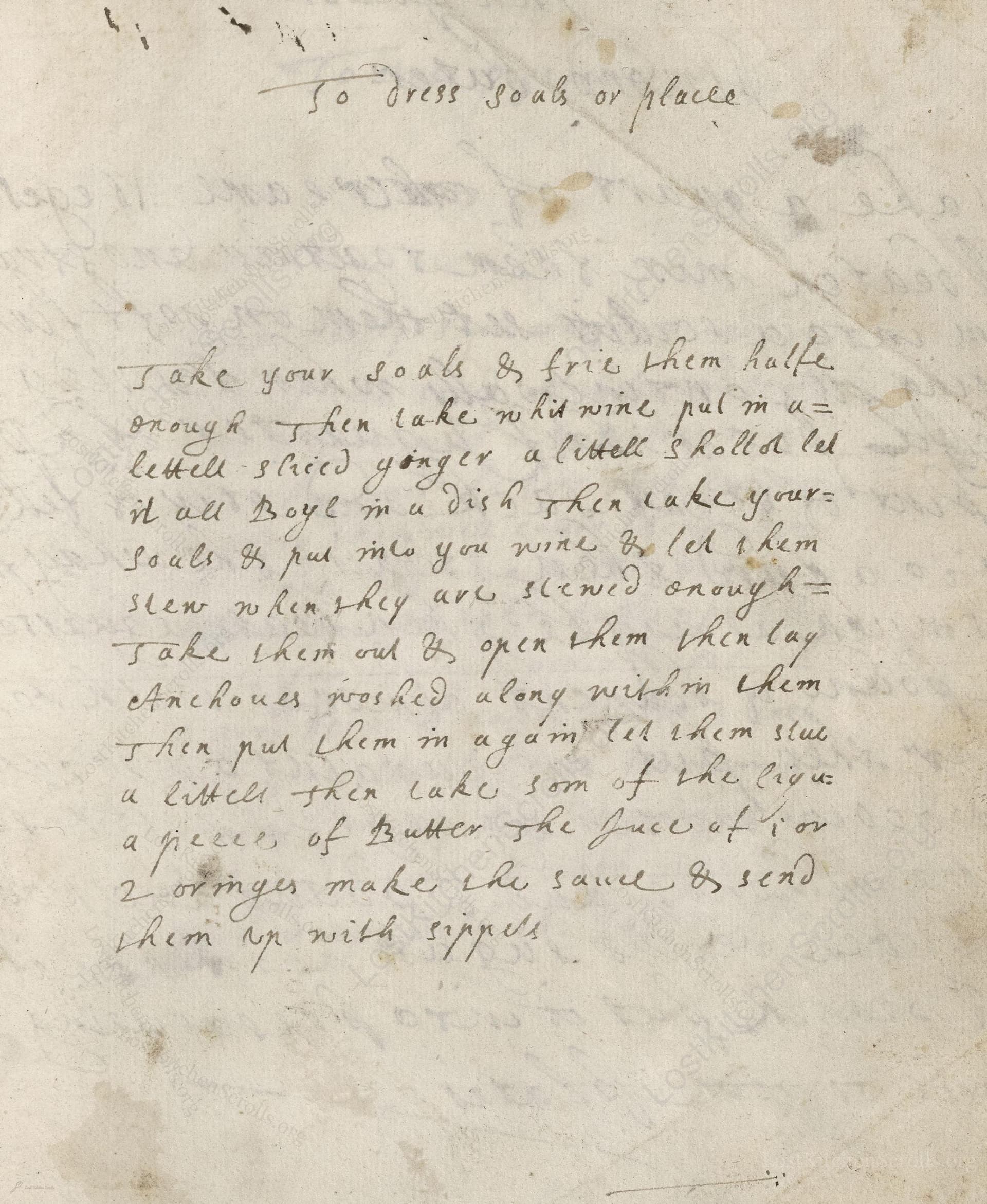To Dress Soals Or Place
From the treasured pages of Cookbook of Susanna Packe
Written by Susanna Packe

To Dress Soals Or Place
"Take your soals & frie them halfe enough then take whit wine put in a lettell sliced ginger a littell shollot let it all boyle in a dish then take your soals & put into you wine & let them stew when they are stewed enough take them out & open them then lay anchoues washed along within them then put them in again & let them stew a littell then take som of the liquor a peece of butterr the juce of 1 or 2 oringes make the sawce & send them up with sippets"
Note on the Original Text
The recipe is written in a conversational, almost telegraphic style, reflecting its origins as practical advice for those already familiar with the basics of cookery. There are no quantities or timings; instead, the cook is expected to exercise judgement and rely on experience. Spelling ("frie," "lettell," "shollot," "oringes") follows 17th-century usage, with variable phonetic forms. The lack of punctuation and free-flowing instructions make these recipes challenging for modern cooks, but they provide a vivid glimpse into the flexible, improvisational world of early modern kitchens.

Title
Cookbook of Susanna Packe (1674)
You can also click the book image above to peruse the original tome
Writer
Susanna Packe
Era
1674
Publisher
Unknown
Background
A delightful culinary treasure from the 17th century, this book offers a charming glimpse into the flavors and techniques that graced English kitchens in Susanna Packe's time, promising a feast of history and taste for any food enthusiast.
Kindly made available by
Folger Shakespeare Library
This recipe comes from the handwritten collection of Susanna Packe, dating to 1674 England, a period when manuscript cookbooks were treasured documents, often passed down within families. Recipes like this reflect both domestic skills and a fascination with cosmopolitan flavours—using imported spices, anchovies, and citrus, all becoming fashionable in the late Stuart era. Wine-based sauces and the inclusion of orange juice, a luxury ingredient, suggest a dish that would appear on the table of a reasonably affluent household, keen to impress guests with the latest culinary trends from the Continent.

The dish would have been cooked using a fire-heated hearth or simple open range, with heavy iron pans or posnet pots for frying and stewing. A small knife would be used to open the fish, while sauces might be finished in a tall copper saucepan. Sippets were made by toasting or frying slices of bread directly at the fire or on a gridiron. A wooden spoon or spatula, and possibly a slotted spoon for moving the delicate fish, would complete the typical battery of kitchen tools.
Prep Time
10 mins
Cook Time
25 mins
Servings
2
We've done our best to adapt this historical recipe for modern kitchens, but some details may still need refinement. We warmly welcome feedback from fellow cooks and culinary historians — your insights support the entire community!
Ingredients
- 2 medium soles or plaice (about 1.5–2 lb total, cleaned and scaled)
- 2 tbsp vegetable oil (for frying)
- 7 fl oz dry white wine
- 1 tbsp fresh ginger, thinly sliced
- 1 small shallot, finely sliced
- 4–6 anchovy fillets (in oil or salt, rinsed if needed)
- 2 tbsp unsalted butter
- Juice of 1–2 oranges
- Small pieces of toasted bread (sippets)
Instructions
- Begin by taking whole plaice or sole (about 2 medium fish, cleaned and scaled) and frying them in about 2 tablespoons of vegetable oil until lightly golden on each side—but only half-cooked.
- In a wide shallow pan, pour in 7 fl oz of dry white wine.
- Add 1 tablespoon fresh ginger, thinly sliced, and 1 small shallot, finely sliced.
- Bring this mixture to a gentle boil.
- Transfer the half-fried fish into the wine mixture and let them gently stew, covered, for 10–12 minutes, until the fish is cooked through and the flavours have fused.
- Lift the fish out carefully and, using a knife, open the fillets along the backbone.
- Lay 2–3 anchovy fillets (rinsed under cold water to mellow the salt) within each fish, then close them and return to the pan.
- Let them stew together for another 2–3 minutes.
- For the sauce, remove some of the stewing liquor (about 3.5 fl oz), whisk in 2 tbsp unsalted butter and the juice of 1–2 oranges.
- Heat gently just until the butter melts and the sauce is emulsified.
- Serve the fish garnished with sippets (small toasted pieces of bread), and pour the sauce over to finish.
Estimated Calories
340 per serving
Cooking Estimates
You'll need about 10 minutes to get your ingredients and workspace ready. Cooking the fish, making the sauce, and stewing everything together takes about 25 minutes. Each serving contains about 340 calories. This recipe makes 2 servings.
As noted above, we have made our best effort to translate and adapt this historical recipe for modern kitchens, taking into account ingredients nowadays, cooking techniques, measurements, and so on. However, historical recipes often contain assumptions that require interpretation.
We'd love for anyone to help improve these adaptations. Community contributions are highly welcome. If you have suggestions, corrections, or cooking tips based on your experience with this recipe, please share them below.
Join the Discussion
Rate This Recipe
Dietary Preference
Main Ingredients
Occasions

Den Bockfisch In Einer Fleisch Suppen Zu Kochen
This recipe hails from a German manuscript cookbook compiled in 1696, a time whe...

Die Grieß Nudlen Zumachen
This recipe comes from a rather mysterious manuscript cookbook, penned anonymous...

Ein Boudain
This recipe comes from an anonymous German-language manuscript cookbook from 169...

Ein Gesaltzen Citroni
This recipe, dating from 1696, comes from an extensive anonymous German cookbook...
Browse our complete collection of time-honored recipes



